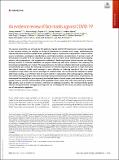An evidence review of face masks against COVID-19
Author(s)
Howard, Jeremy; Huang, Austin; Li, Zhiyuan; Tufekci, Zeynep; Zdimal, Vladimir; van der Westhuizen, Helene-Mari; von Delft, Arne; Price, Amy; Fridman, Lex; Tang, Lei-Han; Tang, Viola; Watson, Gregory L.; Bax, Christina E.; Shaikh, Reshama; Questier, Frederik; Hernandez, Danny; Chu, Larry F.; Ramirez, Christina M.; Rimoin, Anne W.; ... Show more Show less
Downloade2014564118.full.pdf (736.0Kb)
Publisher Policy
Publisher Policy
Article is made available in accordance with the publisher's policy and may be subject to US copyright law. Please refer to the publisher's site for terms of use.
Terms of use
Metadata
Show full item recordAbstract
The science around the use of masks by the public to impede COVID-19 transmission is advancing rapidly. In this narrative review, we develop an analytical framework to examine mask usage, synthesizing the relevant literature to inform multiple areas: population impact, transmission characteristics, source control, wearer protection, sociological considerations, and implementation considerations. A primary route of transmission of COVID-19 is via respiratory particles, and it is known to be transmissible from presymptomatic, paucisymptomatic, and asymptomatic individuals. Reducing disease spread requires two things: limiting contacts of infected individuals via physical distancing and other measures and reducing the transmission probability per contact. The preponderance of evidence indicates that mask wearing reduces transmissibility per contact by reducing transmission of infected respiratory particles in both laboratory and clinical contexts. Public mask wearing is most effective at reducing spread of the virus when compliance is high. Given the current shortages of medical masks, we recommend the adoption of public cloth mask wearing, as an effective form of source control, in conjunction with existing hygiene, distancing, and contact tracing strategies. Because many respiratory particles become smaller due to evaporation, we recommend increasing focus on a previously overlooked aspect of mask usage: mask wearing by infectious people (“source control”) with benefits at the population level, rather than only mask wearing by susceptible people, such as health care workers, with focus on individual outcomes. We recommend that public officials and governments strongly encourage the use of widespread face masks in public, including the use of appropriate regulation.
Date issued
2021-01Department
Massachusetts Institute of Technology. Department of Aeronautics and AstronauticsJournal
Proceedings of the National Academy of Sciences
Publisher
National Academy of Sciences
Citation
Howard, Jeremy et al. "An evidence review of face masks against COVID-19." Proceedings of the National Academy of Sciences 118, 4 (January 2021): e2014564118
Version: Final published version
ISSN
0027-8424
1091-6490